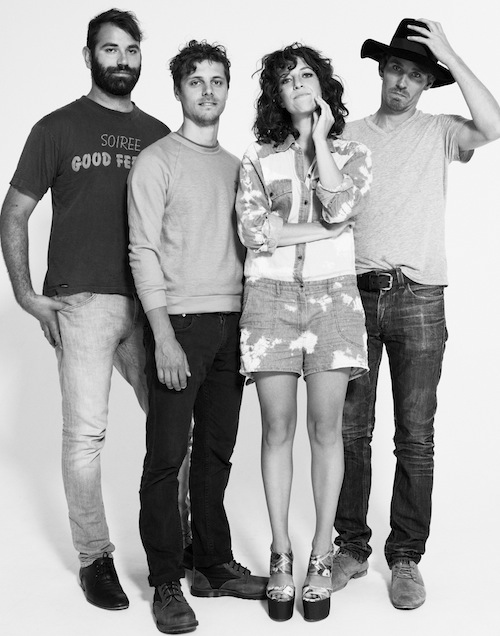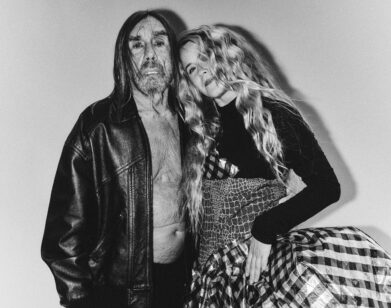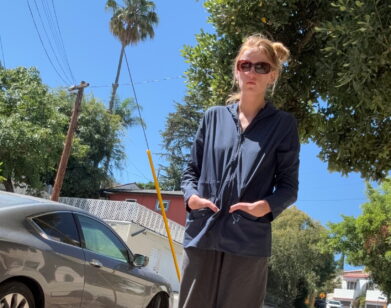The Reanimation of The Luyas

ABOVE: JESSIE STEIN AND HER BANDMATES IN THE LUYAS. IMAGE COURTESY OF RICHMOND LAM
Between the Presidential election and Hurricane Sandy, New York City is having a tough go of it when it comes to keeping a date with The Luyas. As the Montreal rockers prepared for their upcoming tour behind their recently released third album, The Animator, they took a second look at their American dates and noticed that they had a show scheduled on election night. They moved the set to an earlier date (this Saturday) and to a venue down the block (from the Mercury Lounge to Cake Shop)—and then Hurricane Sandy hit, which has left the Lower East Side (and, obviously, its venues) in the dark.
As of right now, Cake Shop is dry, but without power, and the status of The Luyas’ show is still dependent on whether or not the lights turn back on below Houston—hell, below 39th Street—this weekend. According to Jessie Stein, lead singer and the band’s resident guitar/keyboard/Moodswinger juggler, getting stood up by New York for reasons beyond their reach doesn’t mean that they love the city any less. They’re thrilled to be hitting the road, they can’t wait to play their first headlining dates abroad, and they’re hardly shying away from sharing their most personal record yet with the world—come holidays or high water.
HILARY HUGHES: What are you looking forward to the most about heading out on tour behind Animator?
JESSIE STEIN: This is our first time trying to do headlining shows, which is a crazy, scary thing! For the first time, the set we’re preparing can be really dynamic, because it’s not just 30 minutes of trying to convince another band’s fans to listen to you. It’s a totally different exercise. You can play different sides of your music when you know you’re playing for people who are there to see you, and you don’t have to grab for their attention—they’re there because they already like your work. I’m excited to play some of the more subtle songs. We’re doing the same thing when it comes to rehearsing and putting together a show, but it sounds good and feels good, and the nature of the songs seem different. I think we’re going to be able to make it a more artistic experience, even though we’ll be playing for smaller clubs. I hope we’ll be able to engage on a more personal level with the people who are there for us.
HUGHES: When I think of The Luyas, I think of unexpected sounds—French horns, lap steel, that crazy Moodswinger thing you play. Do you bring all of those instruments out on the road with you?
STEIN: We bring that all with us everywhere. That’s why we’ve got such nice arms—they’re from carrying all our gear! [laughs] We try to be smart, but we also don’t want to make all of our decisions based on efficiency. The French horn has always toured with us; the Moodswinger has come everywhere with us since I got it.
HUGHES: Is there anything you’ve learned from picking up these not-so-normal instruments that you wouldn’t necessarily get from playing a guitar? How has their inclusion especially benefited the sound of The Luyas?
STEIN: Everybody in the band is playing their primary instruments. Pietro’s been playing French horn since he was a kid; Mikey’s been playing steel guitar for years. I’m the only person in the band who really has no idea what they’re doing! [laughs] There was a point a few years ago where I just kind of fell out of love with my guitar—I just couldn’t hear anything in it. It’s like cooking the same thing for dinner every night: You may get really good at it, but eventually you won’t even taste it. So, I play the Moodswinger because it’s such a special and arresting sound. I definitely get a lot of sounds out of it, and interestingly enough, it’s lead me back to my guitar, which is really cool, because the guitar is much more thorough and makes a lot more sense than the Moodswinger. It does much more stuff as a communication device, you know? The Moodswinger kind of tells you what it does, as opposed to showing what it can do. I really like the ping-pong of being naïve and discovering songs through sound, and then suddenly knowing exactly what I want to say and going to this instrument I trust and know how to control. The Moodswinger kind of controls me and controls my writing, and the guitar is an instrument that I can tell what to do. I really like having both of those.
HUGHES: Did that balance between those instruments change with Animator, or did you play around with different sounds on this particular record that you hadn’t before?
STEIN: Actually, I don’t play any songs on the Moodswinger on this record—I play guitar and keyboard, though I did write some of the songs on the Moodswinger, and then I played them either on keyboards or guitar. We made this record so fast; it was such a burst of feeling. The Moodswinger is really hard, and I just thought that the most important thing about Animator is the feeling, the creepiness and the vibe, and we just needed to catch it when we had it. The Moodswinger takes a lot of composition, and I just didn’t feel like it this time, though we’re going to make more songs with it. I just like writing from a slightly insecure musical place, because it leads you into different chord progressions. What’s different with this record is that it’s much more subtle and patient, and I think that the actual sentiment is much more clearly executed. Too Beautiful to Work is more of an aesthetic expression. I love that record and stand behind it, but Animator is close to my heart because I think that the lyrics are much more clear and I think that it reflects life better. It’s not triumphant, and it’s not dramatic, but it has this feeling of weltschmerz, that German word for world-weary, and I like that. The thing that I’m proud of with Animator is that it’s more about the feeling and less about the sound.
HUGHES: Wasn’t there also a really tragic catalyst for this? I read that you all received news of a friend’s sudden passing right when you were going into the studio to record Animator.
STEIN: Someone who was really close to the band died. It was the first day we were recording. Every record is about life and death, anyways, you know? Death is super normal. It’s a part of everything. And it’s the subtext of all the bad things and the great things that happen in our lives. Knowing that life is going to end makes every moment important, and I think it’s something that we don’t talk about very much. So, that was going to be a part of it anyways, but it definitely gave a lot of focus to what kind of art we made. We were all going through the same feeling at the same time. Even though it’s the most normal thing in the world, that sort of thing provokes all kinds of philosophical moments between a bunch of close friends who try to make their lives about singing about life or whatever. I think that you can feel it when you hear the record. I think our friend would’ve liked it.
HUGHES: Is that difficult for you, though? To revisit Animator and where you were at emotionally and otherwise when you were recording it?
STEIN: It’s painful to lose somebody. I’m not one of those people who wants to walk away from that kind of pain. Thinking about it is kind of interesting, because you realize that all you can do is think on that for a second, the finality of life. I think there’s a lot of denial or dismissal in our culture about the fact that we’re all going to die, and I think that’s something to notice. So, I don’t listen to the record and get really sad; I want to feel something, because that means it’s worth something.
HUGHES: Is that what you walked away from Animator with? What did you learn from Animator or the creative process behind it?
STEIN: Making this record, I learned a lot about music—about how it kind of happens when you’re dreaming, about how I can trust my friends, about how great my collaborators are. I’m constantly learning that my bandmates are such deep wells of ideas. I think that the first thing that I learned making this record, personally, is just how much I can trust them and how lucky I am to have them as friends and also people that I get to consistently trade ideas with. They’re the most consistent relationship I’ve ever had besides my family. They’re so cool. They’re insane.
THE LUYAS’ ANIMATOR IS OUT NOW. THE BAND WILL PLAY CAKE SHOP TOMORROW NIGHT, NOVEMBER 3, IF ITS POWER IS RESTORED IN TIME FOR THEIR SHOW.






